Howard Smith Ltd - T.S.S.
Canberra 1913 to 1947, then owned by the Greek Line 1947 to 1954, owned by the
Please Note: Firefox and some other Search Engines may not be suitable
Use Google Chrome for this Web Page to load perfectly!
Click the logo above to reach the ssMaritime FrontPage for Ships of the Month & News Updates
With Reuben Goossens
Maritime Historian, Cruise‘n’Ship Reviewer, Author & Lecturer
Please
Note: All
ssMaritime and other related maritime sites are 100% non-commercial and
privately owned, thus ssmaritime is NOT associated with any shipping company or
any other organisation! Although the author has worked and has been involved in
the passenger shipping industry for well over 60 years, but due to his old age
and poor health, he was forced to retire. Yet, he has completed well over 1,435
Classic Liners, Passenger-Cargo Liners as well as humble converted C3 converted
Migrant Liners, which has transported countless thousands of folk to the new
world, as well on vacations’. I trust the features online will continue
to provide Classic Liner and Ship enthusiasts both the information they are
seeking, but more so provide a great deal of pleasure and relive many happy
memories!
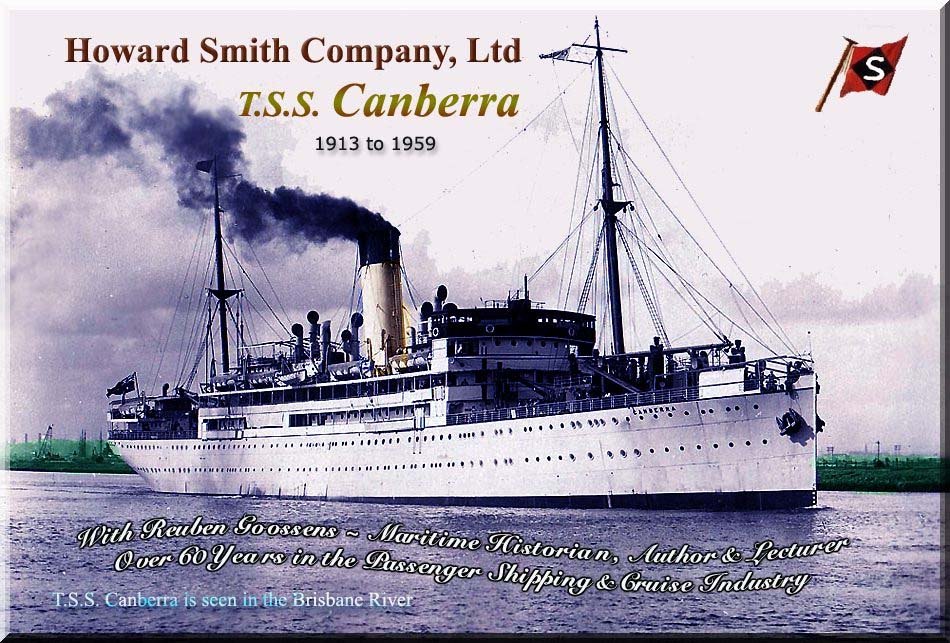
T.S.S. Canberra above is seen between the years after WWI and before WWII
Photographs are from the ssMaritime historic collection - unless stated otherwise
I wish to thank the “State Library of Queensland” (SLQ) & “State Library of Victoria” (SLV) for their wonderful contribution
Introduction:
Howard Smith Limited had a long and a proud history in Australian shipping which goes back to the 1850’s when the Englishman Captain William Howard Smith (born in Yarmouth, England in 1813) together with and a friend, who was a marine engineer Mr. Skinner, obtained a 199-ton iron hulled single screw steamer, but was a fully schooner-rigged vessel named “Express”, and he set off with his family for Melbourne, Australia, where they arrived in May 1854. He and Skinner, the marine engineer became involved with the Parker brothers and together they played a big part in setting up the Australian coastal shipping company “Huddard Parker Ltd”.
However, Captain Howard Smith really desired
his own coastal Shipping Company in
S.S. You Yangs:
In the
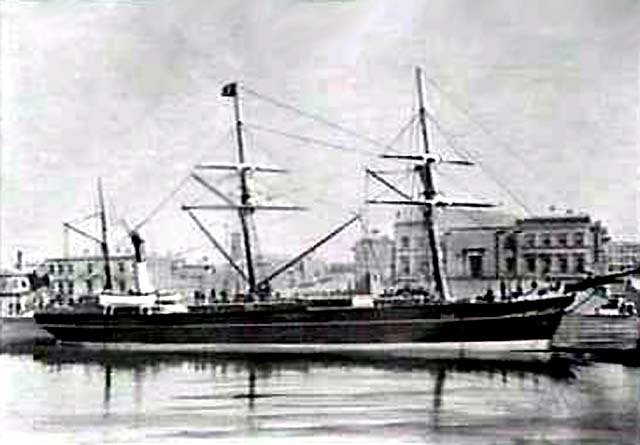
S.S. “You Yangs” the very first ship under the Howard Smith name in 1883
However at that time she operated by the current company name of “Melbourne Steam Ship Company” and she was placed on a varied service, sailing between Melbourne, Sydney and Newcastle, New South Wales as well as voyaged to the Island state of Australia Tasmania as well as South Australia as required.
In November 1869 the “You Yangs” was reregistered in
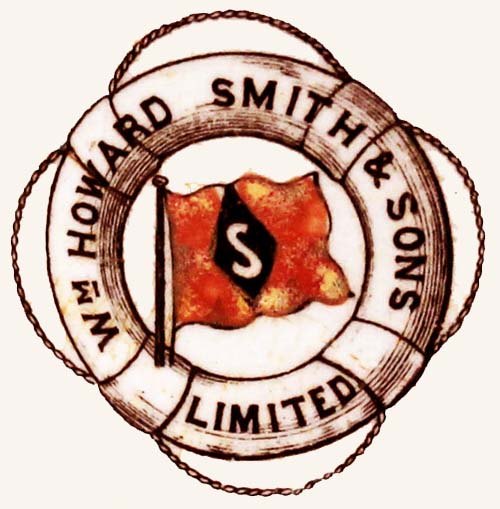
A W. Howard Smith & Sons Limited lifebuoy logo from the late 1880’s and early 1900’s
Then during a voyage south, the You Yangs struck a rock, and was abandoned East of Kangaroo
Island (near Pelorous Island) South Australia, on the
June 14, 1890, she was badly holed thus she rapidly took on water and began to
sink. Her captain called for his crew of 20 to abandon ship, and the captain
was the last to leave the sinking vessel.
S.S. Bombala:
Obviously time has passed and there have been other ships, but the S.S. “Bombala” of 1904 was the first of a new and a larger series of passenger Cargo liners to operate along the Australian coast.
The 3,540-ton Bombala
was a steel steamship built by
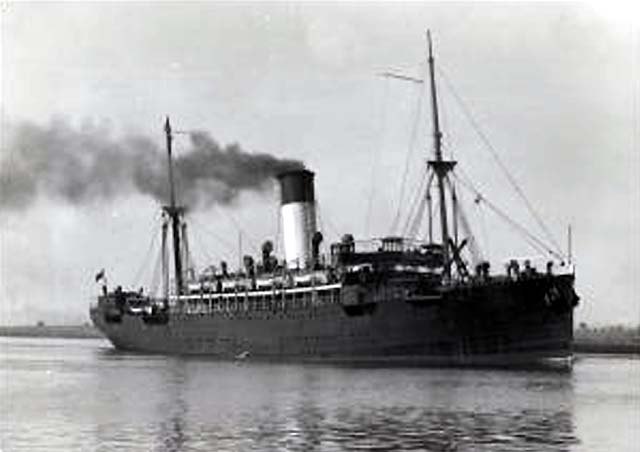
A
fine photograph of the S.S. “Bombala” the
forerunner of the Passenger, Melbourne to
She was powered by a four Cylinder Triple
Expansion Engine with four single ended coal fired boilers. As of 1913 she
mostly serviced the more popular
Finally she was sold 1929 to London interests,
and was renamed “Aspasia”, but six years later she was sold
again in 1935 to Italian interests and was renamed “Christos”,
however sadly she was scrapped in that same year at Savona Italy.
S.S. Cooma:
The 3,839-ton passenger cargo liner S.S. “Cooma” was built by Alexander Stephens & Sons Ltd, Linthouse in 1907. She was powered by one x 3 Cylinders Triple Expansion Steam Engine, with a single shaft, and a single screw, with four coal fired boilers with a forced draught.
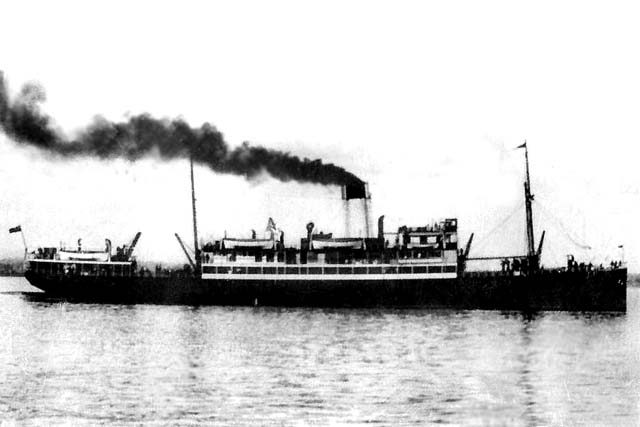
The S.S. “Cooma” was the second of a Trio, but the next ship would be twice their size!
Howard Smith Ltd.,
One afternoon on July 7, 1926, the S.S. Cooma departed Brisbane bound for Cairns, with some 250
passengers on board, music was playing as they departed and every one was
looking forward to warm and sunny days ahead up north in Cairns during the
Australian winter as it would be cold down in Melbourne and Sydney! However, as
she headed northward it was later in that same day that several other Burns Philp ship the S.S. Burwah
received SOS calls coming from the much larger liner Cooma
and two other Burns Philp steamers the Morinda and Malabar did as well. The Burwah
was on a voyage sailing south from Rockhampton down
to
Cooma’s Captain Maine sent a radio message to Burwah’s Master that his “ship was making some water”, but that she was not in immediate danger. However considering that relatively heavy seas were running, thus the Burwah remained close by during the night. Thankfully the next morning the seas proved to be calmer and all of Cooma’s 250 passengers were transferred to the Burwah who were safely taken to Port Alma. During the day the H.M.A.S. Moresby which had also arrived, but her Commander reported that he felt that the S.S. Cooma was a complete wreck, and that he had taken off all her crew. There were attempts to secure and refloat her, and many tons of cargo worth at least £20,000 had been removed from Cooma’s holds to another freighter, whilst perishables had been tossed overboard. But finally she was declared a total wreck and in May 1927 what was left of her was sold for the sum of £150. In conclusion, Cooma’s Captain Maine was charged with lack of Caution, not doing his job, for he should have remained on the bridge, etc, etc, and his masters ticket was suspended for (what?) just a lousy two months.
T.S.S. Canberra:
We have finally come to the ship that is the main part of this feature, the magnificent, and one of the first “Fast Passenger Liner” especially designed for the Melbourne, Sydney, Brisbane, Mackay, Townsville to Cairns service and she was known to have beaten the Sydney to Brisbane rail service on a good number of occasions, that was until their shorter and faster coastal railway service to Brisbane was finished.
The 7,710 GRT, T.S.S. “Canberra” was built by Alexander Stephen & Sons at Linthouse ship-yards in Scotland, and she was launched on November 9, 1912, as soon she was in the water, she was towed to her fit-out berth, where she would be finished, and amazingly she was fully completed just four months later.
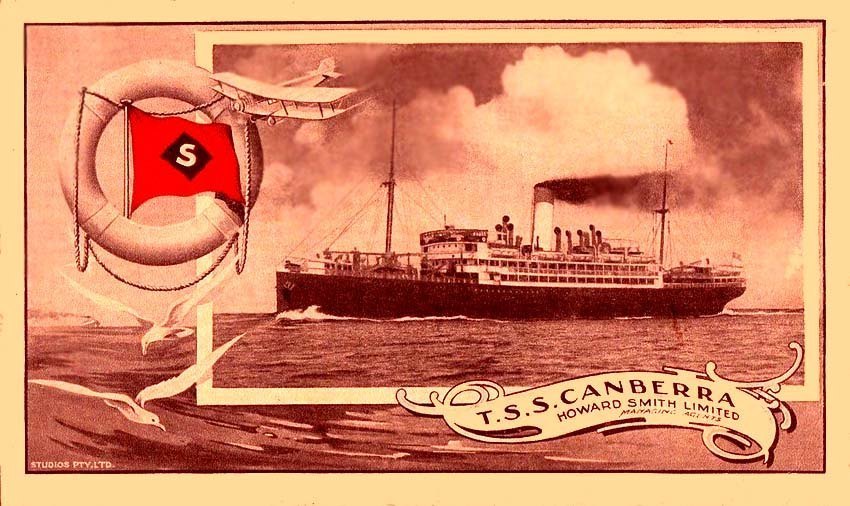
A
very early publicity image of the T.S.S. “
The brand new T.S.S.
Canberra headed to
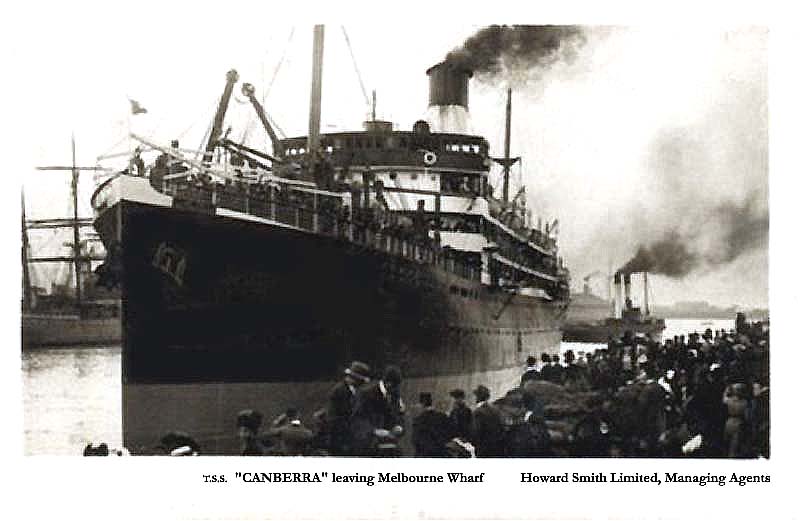
A
Howard Smith postcard of the T.S.S. Canberra
departing
Having been made ready in Melbourne for her new service, her Australian Passenger and Cargo coastal service soon commenced, and she joined the S.S. Bombala and the S.S. Cooma on the very popular northward coastal service to North Queensland, sailing via Sydney and Brisbane and other ports to tropical Cairns.
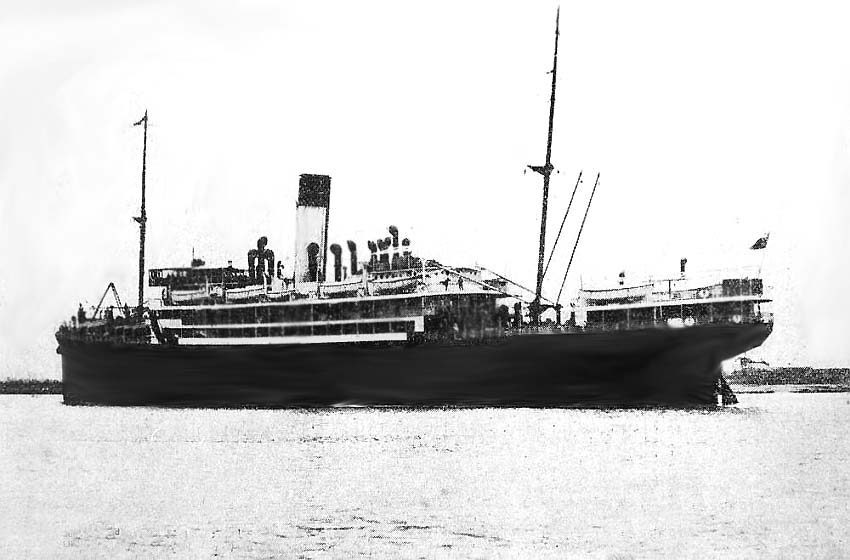
T.S.S. Canberra is seen departing
State
Library of
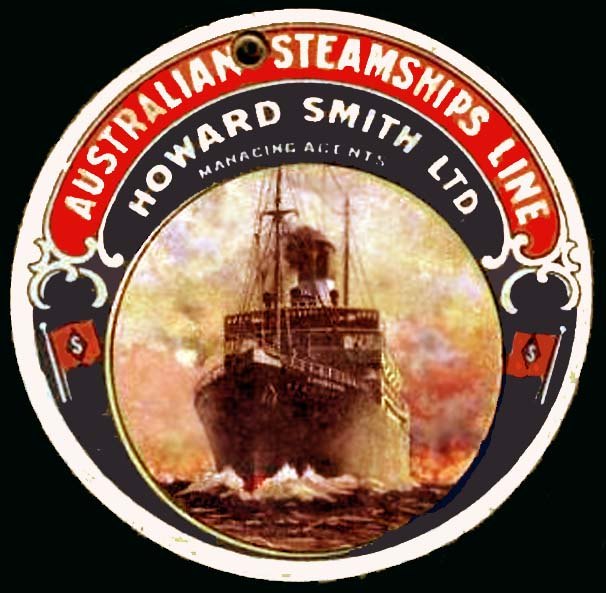
A
typical Howard Parker “
Her Accommodations and Public Venues:
The
Her Public Venues were located on Promenade Deck forward where there was a Lounge and a Smoking Room with a Bar and Verandah as well as the First Class main Lobby, which fitted an elevator (lift), outside where a Promenade Deck, and topside was the spacious First Class Sun/Sports Deck.
The other two classes occupied the balance of the ship, with a good number of lounges located aft on Promenade Deck and A Deck, with spacious deck areas, both covered and exterior, as well as having sport facilities; they shared the public facilities and Dinning Room.
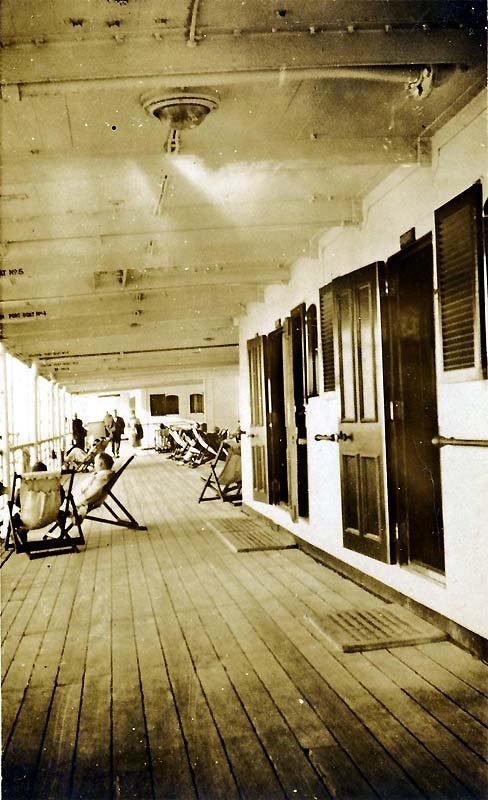 -
- 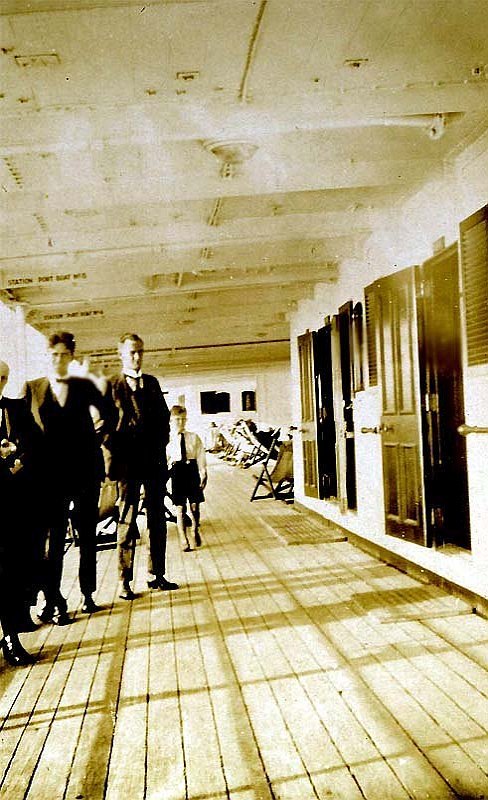
First
Class Passengers seen on Promenade Deck
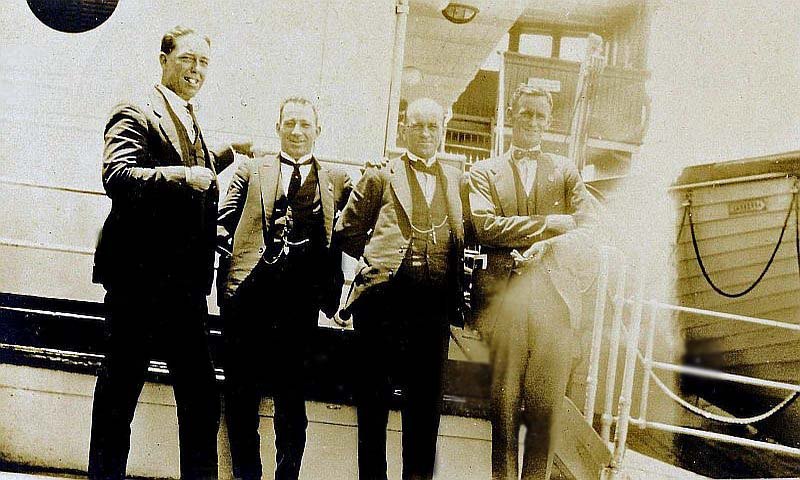
Above
& below: Male passengers up on Sun Deck, above
forward, below far aft
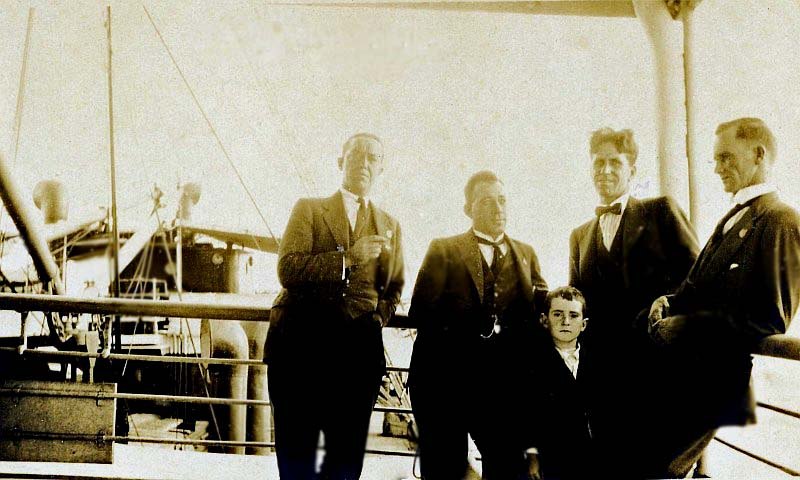
B Deck also had cabins located both forward and aft, whilst on C Deck cabins occupied the entire deck.
There were two Dinning Rooms, both located on B Deck, one large Dinning Room located forward and a second one aft, but sadly I do not have any photographs of her interiors.
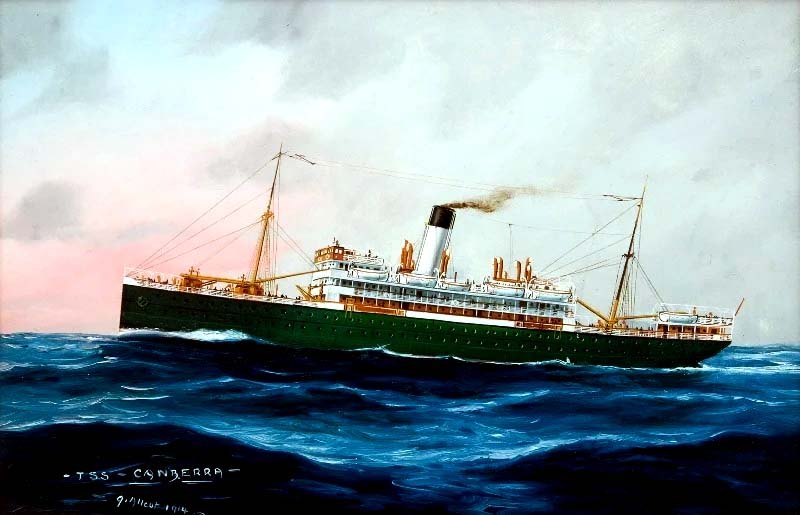
A delightful painting of the T.S.S. Canberra
Painting by & © John Allcot
T.S.S. Canberra offered a reliable service and she became a much loved ship with those who used her as a transport ship, as well as a cruise ship. She tended to depart Melbourne and Sydney fully booked with passengers, many of whom would have booked a round voyage, much like today’s cruises, and her holds would be full, thus financially she was very successful, being such a fast ship for her days!
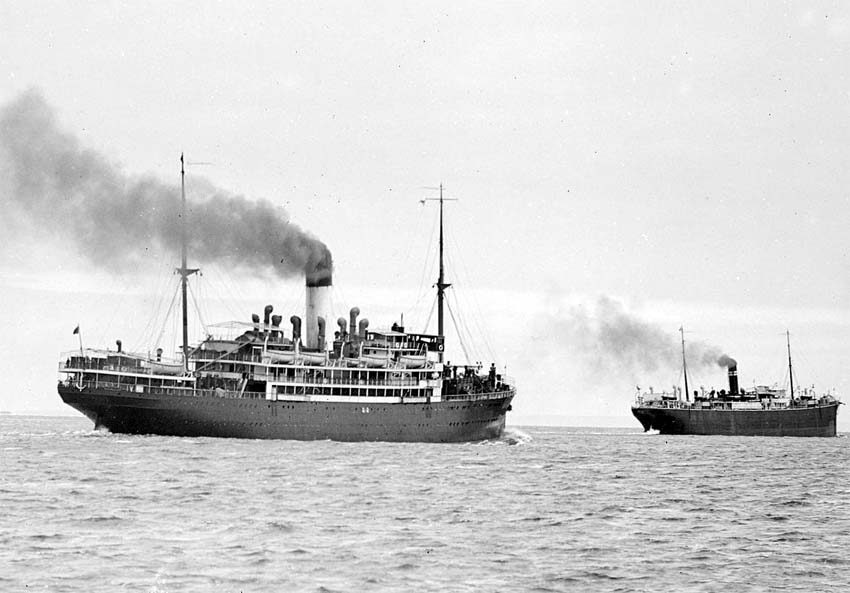
The T.S.S Canberra is seen arriving and about to enter
Ahead of her is an unknown ship - the date is unknown
State
Library of
But sadly her days would end after four years
of operations as the war that was called “The Great War”, or
“World War One” was on the horizon and the
Service during World War One:
H.M.A.T. Canberra:
Between 1917 and 1919 she served as an Australia Troopship, but was placed under the management of the “British India Steam Navigation Company”.
In October 1917 the
With her conversion completed in Sydney the H.M.A.T. Canberra was commissioned on November 15, 1917,
and on November 16, the Canberra embarked 723 “Australian Imperial
Force” (AIF) personnel as; 1st Field Artillery
Brigade 32nd Reinforcements, 25th Infantry Battalion 21st Reinforcements, 1st
Light Horse Regiment 33rd Reinforcements, 4th Light Horse Regiment 33rd
Reinforcements, 6th Light Horse Regiment 33rd Reinforcements, 7th Light Horse
Regiment 33rd Reinforcements, 12th Light Horse Regiment 23rd Reinforcements,
Camel Reinforcements (part), 1st Field Squadron Engineers (August &
September) Reinforcements, 1st Signal Squadron Engineers (August & September)
Reinforcements, 1st to 4th Signal Troops (August & September)
Reinforcements, Two Medical Officers (1 Major & 1 Captain), Dental Details,
6 miscellaneous, 2 Red Cross workers, 56 Nurses and Two Chaplains. Her holds
that were not used for troop accommodations, were filled with equipment and
stores and when ready, she departed for
She arrived at Fremantle, where on November
23, she embarked the 16th Infantry Battalion 27th Reinforcements, Railway Unit
(November) Reinforcements, Medical Corps General Reinforcements, Dental
Details, Nurses and One Chaplain, and she departed bound for Egypt. She was
then employed transporting troops between Mediterranean ports and the
After the Armistice was signed at
Thankfully this fine Australian passenger/Troop ship had suffered no damage during the war and thus she was able to be returned to her owners in one piece, unlike so many other ships that had been lost.
Back to Passenger Services:
Thankfully with WWI over, H.M.A.T. Canberra had served valiantly, and she was returned to her owners on April 27, 1920 who sent her to the ship-yards where she was completely and beautifully restored as well as fully updated, etc. However, her exteriors saw quite a transformation, from her old black hull days, as she came out of her restoration with her hull having been repainted a shade of grey with a thin black ribbon up high on the hull, located just below the B Deck port holes. In addition she had now become a Two Class ship, with First Class accommodating 64 passengers and Second Class having 646 passengers.
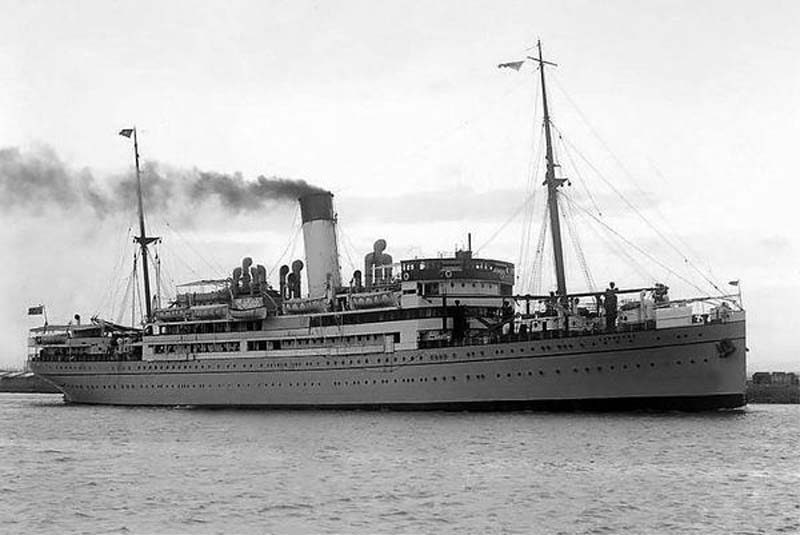
The T.S.S. Canberra is seen after her restoration and arriving
in
State
Library of
First Class:
The
Second Class:
This Class now accommodated 646 passengers and they occupied the balance of the ship, with a good number of lounges aft located on Promenade Deck and A Deck, with spacious deck areas, both covered and exterior, as well as having sport facilities, etc. B Deck also had cabins located both forward and aft, whilst on C Deck cabins occupied the entire deck.
Second Class offered two Dinning Rooms, both located on B Deck, one large Dinning Room located forward and a smaller one aft, the latter being mostly for the economy accommodations.
A Deck Plan can be seen in her next
life as the Greek ship T.S.S. “
The all new
Tragedy Strikes the T.S.S. Canberra:
The
However, she came out of the ship-yard looking
simply superb, but almost a year had been lost. She finally returned to service
in May 1926, and she returned to her northward voyages to the Tropic’s in
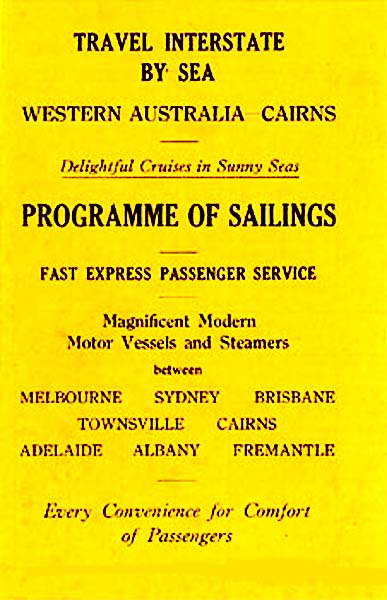
Here is a rather simple cover for Coastal voyages for Howard Smith’s T.S.S. Canberra &
Also
for three other companies; Huddart Parker, Melbourne
Steamship Co, & McIlwraith McEacharn
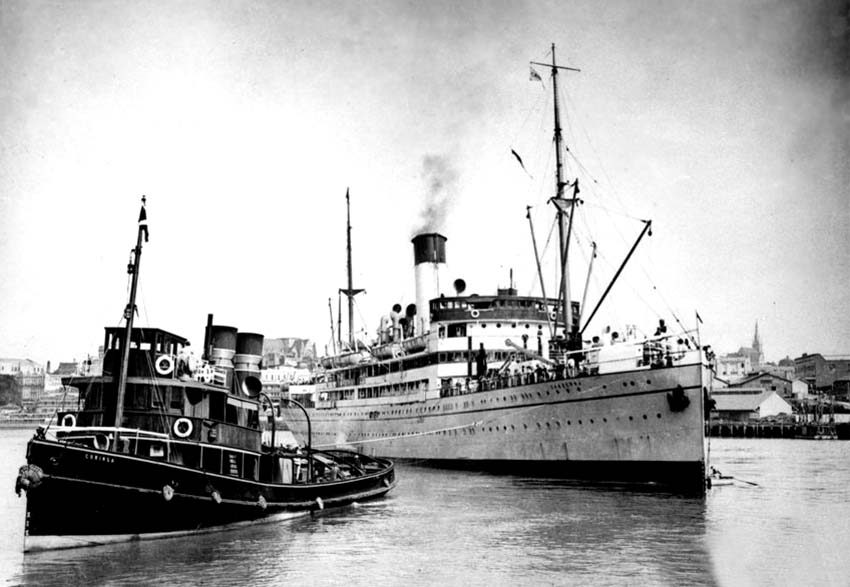
A
fine photo of the
Historic
twin funnelled tug “Coringa” (1914 to
1940)
State
Library of
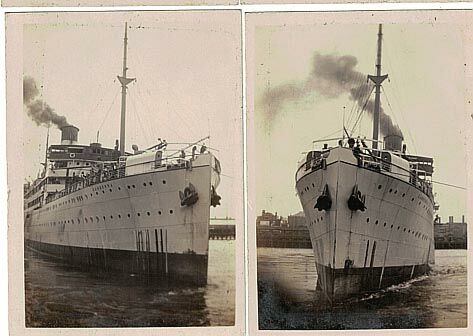 -
-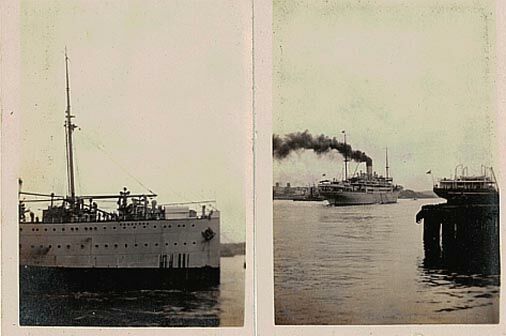
T.S.S. Canberra is seen departing
Sydney, Australia.
The
above photographs were kindly provided by Mr. Stephen Piaud
in May 2025.
Although the photographer was Stephen’s Grandfather Mr. Fred Gosch (senior).
World War Two:
T.S.S. Canberra once again went into service, under requisition from the
“Shipping Controller” from July 1941 and she entered Woolwich
Dry-dock in
These are the dates which I know for sure that
the
The
Canberra
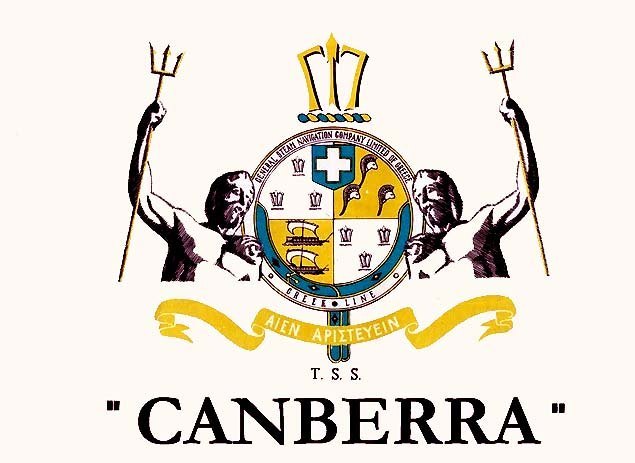
The
Greek Line Deck Plan cover- plan is shown below
The T.S.S. Canberra
was sold just days later on August 21, 1947 to a Singapore-based, Chinese
syndicate for £100,000, who decided for reason of cost, it was better to tow
her from Sydney to Singapore, rather than having to take an Australian captain
and crew there and returning them by air. Thus, with a skeleton crew on board
she departed
She was rapidly resold to the “Ormos Shipping Co” of
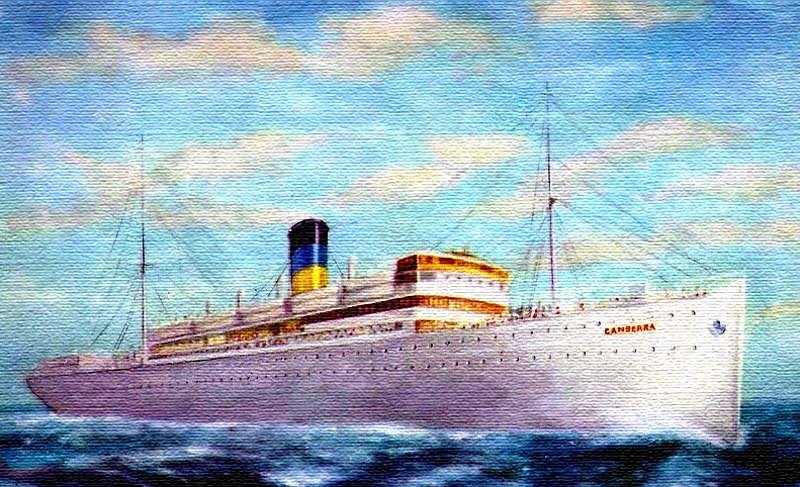
An early artistic postcard from The Greek Line revealing their newly acquired T.S.S. Canberra
With the “
T.S.S.
Canberra Returns to Australia
Then on August 31, 1949 the
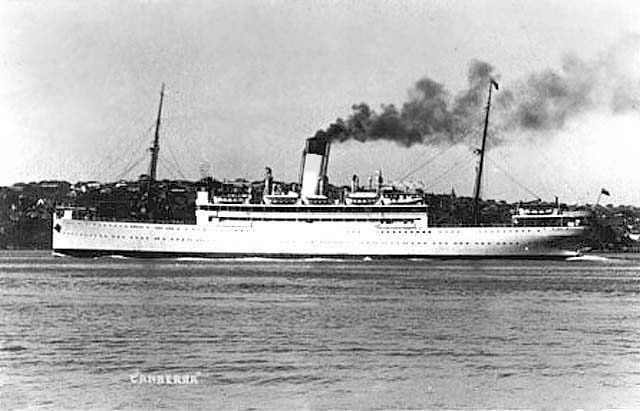
T.S.S. Canberra seen back in Australian waters
Thank you Jason Baker for this photo, but the source is unknown
Please see my photo notes at the bottom of the page
Soon after her arrival in Europe, the
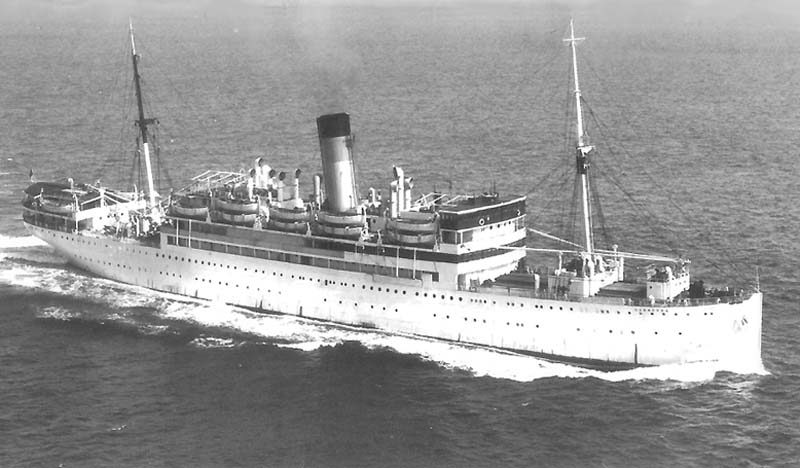
The “
1949 T.S.S. Canberra
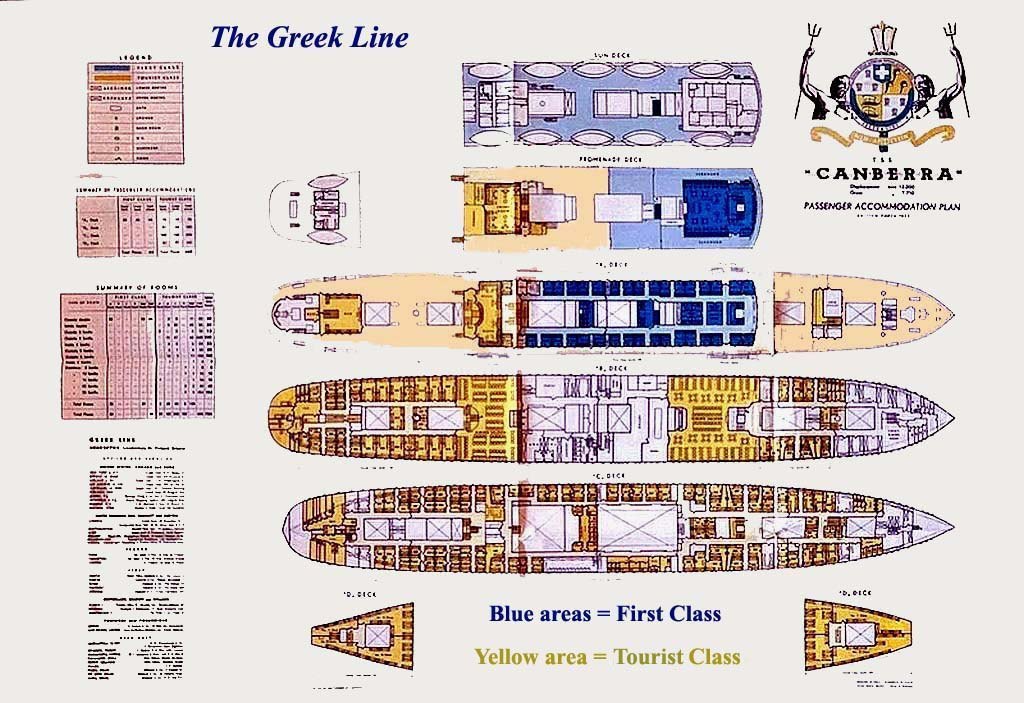
Upon completion, she commenced a new service
for the next five years operating from

A
The Greek Line brochure coving their
Another ship with a back hull is also shown
Having been moved to the Canadian service, she
made a single trip from
Thereafter she returned to
On October 8, 1954 the Canberra made her very
last voyage for “The Greek Line” from Quebec via Cherbourg and
Southampton to Bremen, for it had been decided that she would be retired and
she was sold in that very same month.
Dominican
Republic
By the end of October 1954, the
She operated services to

The T.S.S, España seen towards the end of her days
However, in due course the “España” was transferred to Dominican Republic Navy
and used for troop transport movements with little to no details being
available, this continued until 1959 when she was sold to a local ship breaker,
and she was scrapped that year scrapped in the
***********************************
Details & Specifications T.S.S.
Canberra 1913 - 1954:
Yard: 452.
Built for: “Australian Steamships Limited”.
Managed by: 1. “Howard Smith Ltd” - 1913 to 1947.
“ 2. “The Greek Line” - 1947 to 1954.
Official No: 132441.
Port of registry:
Launched: November 9, 1912.
Maiden Voyage: March 17, 1913.
Tonnage: 7,710 GRT, 6,665 NET.
Length: 410 ft - 125 m.
Breadth 57.2 ft - 17.4 m.
Draught: 33.3 ft - 10.14 m.
Construction: Steel.
Engine: Quadruple expansion steam engine
Propellers: Twin screws.
Speed: 15 knots service speed, 17 knots maximum.
Accommodations:
1913: 170 First, 180 Second, 60 Third Class Passengers.
1920: 64 First, 646 Second Class Passengers.
1949: 52 First, 752 Tourist Class Passengers - “The Greek Line”.
Holds: Four,
including refrigerated space.
***********************************
Let us Conclude with a Beautiful Memory of the …
T.S.S. Canberra
1913 to 1954

Painting
of the Howard Smith Ltd, T.S.S. Canberra by & © -
A.
***********************************
“Blue
Water Liners sailing to the distant shores.
I watched them come, I watched
them go and I watched them die.”
Featuring over 1,435 Classic Passenger Liners, Passenger-Cargo Liners & Classic Cruise Ships!
Or ENTER HERE
For interest: Sadly an email service to ssMaritime is no
longer available, due to the author’s old age and chronic illness as well
as being disabled, etc. In the past ssMaritime received well over 120 emails
per day, but
*********************
ssMaritime.com & ssMaritime.net
Where the ships of the past make history & the 1914 built M.S. Doulos Story.
The Author has been in Passenger Shipping & the Cruise Industry for well over 60 years
In addition he was the founder of “Save the Classic Liners Campaign” in 1990.
Please Note: ssmaritime and associated sites are 100% non-commercial and the author seek no funding or favours of any shape or form, never have and never will!
Photographs on ssmaritime and associate pages are by; the author or from the author’s private collection. In addition there are some images that have been provided by Shipping Companies and private photographers or collectors. Credit is given to all contributors. However, there are some photographs provided to me without details regarding the photographer/owner concerned.
This notice covers all pages; although, and I have done my best to ensure that all photographs are duly credited and that this notice is displaced on each page, that is, when a page is updated!
ssMaritime is owned
& © Copyright by

